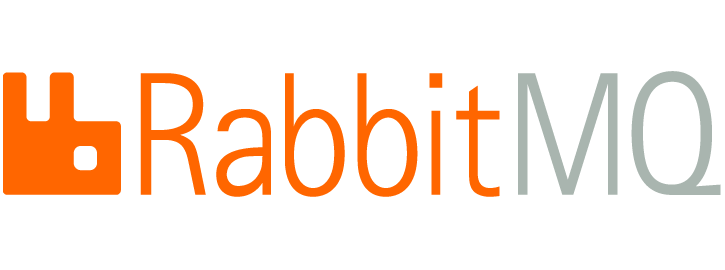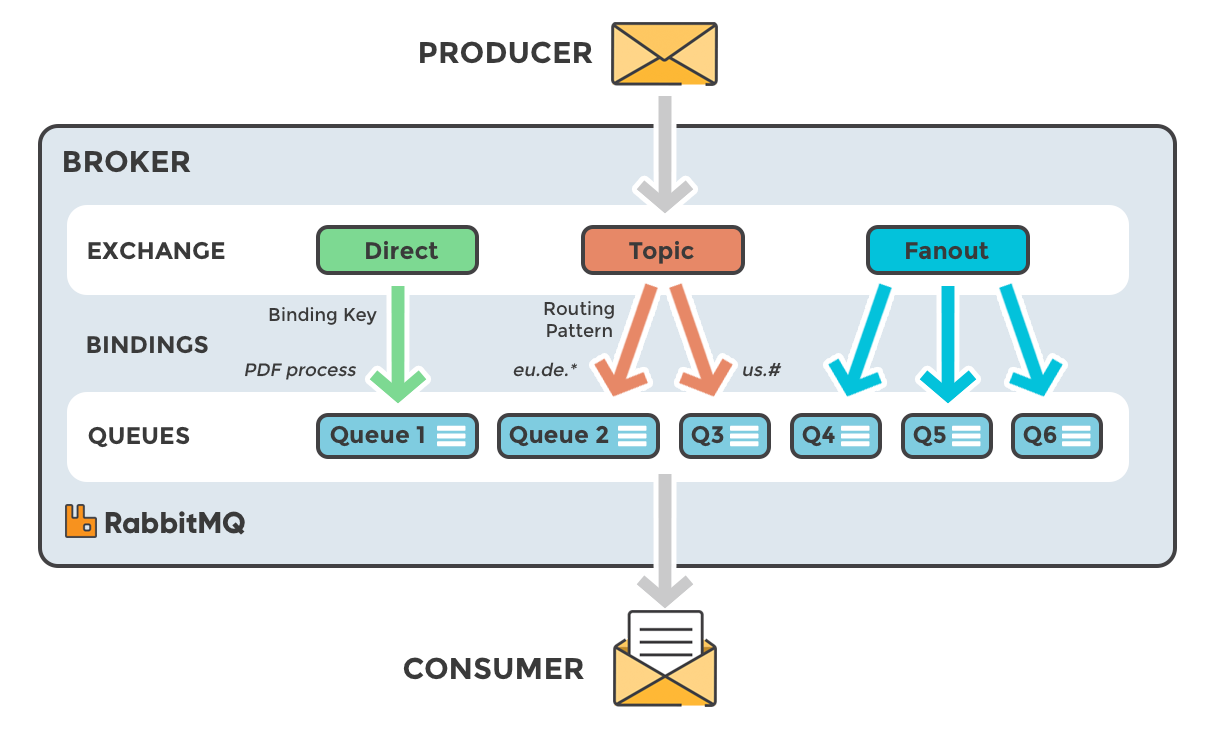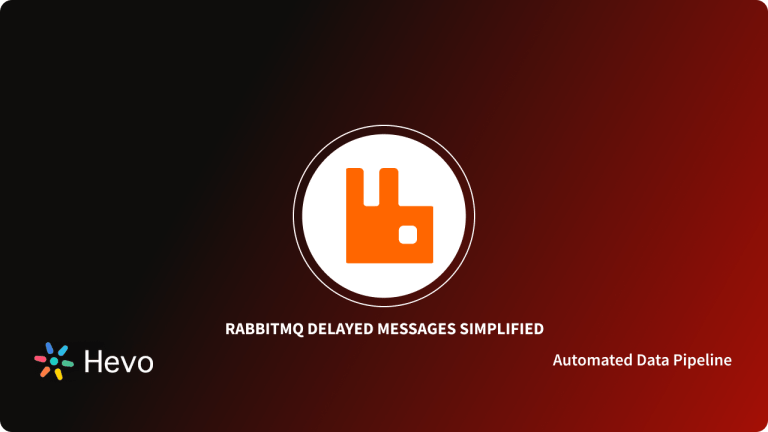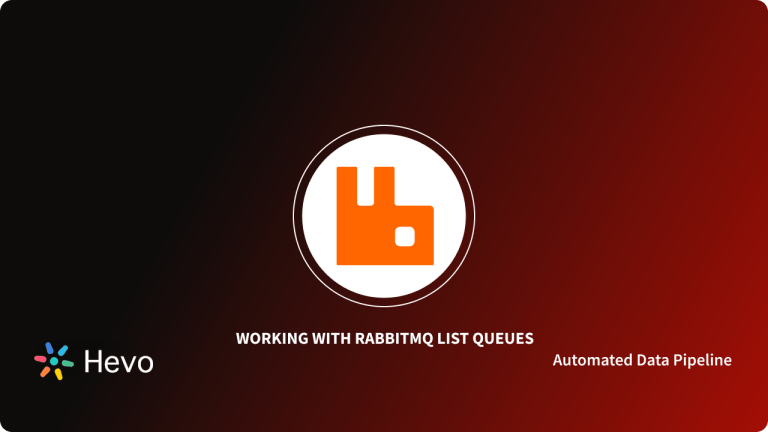RabbitMQ is a lightweight, open-source, and easy-to-deploy message broker that enables services and applications to communicate. It supports multiple messaging protocols like AMQP (Advanced Message Queuing Protocol), and MQTT (MQ Telemetry Transport). STOMP (Simple (or Streaming) Text Orientated Messaging Protocol) and a few more.
RabbitMQ provides powerful, fluid routing capabilities that can adapt to the ever-changing needs of the user and its services. It employs message queues to enqueue and dequeue messages in the FIFO manner, making it easy to scale processes. RabbitMQ exchange receives messages from producers and pushes them to queues depending on the rules defined by the RabbitMQ exchange type.
This guide explores the four RabbitMQ exchange types: direct exchange, topic exchange, fanout exchange, and headers exchange. Before we get into them, we’ll go over the key ideas and how the basic message cycle works in RabbitMQ. In addition, we’ll look at two more types: default and a dead letter.
Table of Contents
What Is RabbitMQ?

Key Features
- Multi-Protocol Support: Works with AMQP, MQTT, STOMP, and WebSockets for diverse integrations.
- Message Queuing: Stores and forwards messages reliably until they are processed.
- Flexible Routing: Supports multiple exchange types (direct, fanout, topic, headers) for message distribution.
- Reliable Messaging: Ensures message durability with acknowledgments, persistence, and retries.
- Scalability: Can be deployed in clusters to handle high loads and ensure fault tolerance.
Read More About RabbitMQ vs ActiveMQ and Apache Kafka vs RabbitMQ.
What Is RabbitMQ Exchange?

In RabbitMQ, a producer never delivers a message straight to a message queue. Instead, it makes use of exchange as a routing middleman. As a result, the RabbitMQ exchange determines if the message is routed to one queue or several queues or is simply discarded.
To provide a brief overview, RabbitMQ exchanges are message-routing agents configured by the virtual host in RabbitMQ. Exchange handles messages to different queues using header attributes, bindings, and routing keys.
Role of RabbitMQ Exchange
RabbitMQ’s exchange is used as a routing mediator to receive messages from producers and push them to message queues according to rules provided by the RabbitMQ exchange type. Each RabbitMQ exchange type uses a separate set of parameters and bindings to route the message. Clients can create their own exchanges or use the default exchanges.
Looking for the best ETL tools to connect your data sources? Rest assured, Hevo’s no-code platform helps streamline your ETL process. Try Hevo and equip your team to:
- Integrate data from 150+ sources(60+ free sources).
- Simplify data mapping with an intuitive, user-friendly interface.
- Instantly load and sync your transformed data into your desired destination.
You can see it for yourselves by looking at our 2000+ happy customers, such as Airmeet, Cure.Fit, and Pelago.
Get Started with Hevo for FreeWhat is the RabbitMQ Message Cycle?
RabbitMQ Message Cycle Concepts
Before you can fully grasp the RabbitMQ message cycle, you must first understand some fundamental concepts:
1. Producers/Publisher
In the real world, producers/publishers can be imagined as people who mail to the post office. In the RabbitMQ world, producers/publishers are operators who send the job to RabbitMQ exchanges. Like postmen, who simply route mail to specified postboxes, RabbitMQ exchanges route tasks to specific queues.
2. Task
In the real world, a task is mail that the postman delivers to the mailbox. In RabbitMQ, a task is to send technical data to be exchanged.
3. Queue
Just like a postbox that holds all our mail, a queue is a container that holds all your jobs, which are processed in a first-in-first-out (FIFO) fashion. In FIFO, messages received are processed and sent first, i.e., processing and delivery happens in the order it is received.
4. Binding
A binding is a “connection” that you build between a queue and an exchange.
5. Routing Key
The routing key is a message attribute taken into account by the exchange when deciding how to route a message.
Basic RabbitMQ Message Cycle
With the basics of the RabbitMQ message cycle in place, let’s look at how the RabbitMQ message cycle works.
Here’s what a basic RabbitMQ message cycle looks like:
Step 1: The producer sends out an exchange message.
Step 2: After receiving the communication, the exchange is responsible for sending it. It uses information from the RabbitMQ exchange type to direct the message to the relevant queues and exchanges.
Step 3: The queue receives and stores the message until the consumer receives it.
Step 4: Finally, the consumer handles the message.
RabbitMQ Exchange Types
1. Direct Exchange
The first RabbitMQ exchange type, the direct exchange, uses a message routing key to transport messages to queues. The routing key is a message attribute that the producer adds to the message header. You can consider the routing key an “address” that the exchange uses to determine how the message should be routed. A message is delivered to the queue with the binding key that exactly matches the message’s routing key.
The direct exchange’s default exchange is “amq. direct”, which AMQP brokers must offer for communication. As is shown in the figure, queue A (create_pdf_queue) is tied to a direct exchange (pdf_events) with the binding key “pdf_create.” When a new message arrives at the direct exchange with the routing key “pdf_create,” the exchange sends it to the queue where the binding key = routing key, which is queue A in this example (create_pdf_queue).
2. Topic Exchange
Topic RabbitMQ exchange type sends messages to queues depending on wildcard matches between the routing key and the queue binding’s routing pattern. Messages are routed to one or more queues based on a pattern that matches a message routing key. A list of words separated by a period must be used as the routing key (.).
The routing patterns may include an asterisk (“*”) to match a word in a specified position of the routing key (for example, a routing pattern of “agreements.*.*.b.*” only matches routing keys with “agreements” as the first word and “b” as the fourth word). A pound symbol (“#”) denotes a match of zero or more words.
In topic exchange, consumers indicate which topics are of interest to them. The consumer establishes a queue and binds it to the exchange using a certain routing pattern. All messages with a routing key that matches the routing pattern are routed to the queue, where they will remain until the consumer consumes them. For the topic RabbitMQ exchange type, “amq.topic” is the default topic exchange that AMQP brokers must provide for message exchange.
3. Fanout Exchange
A fanout exchange, like direct and topic exchange, duplicates and routes a received message to any associated queues, regardless of routing keys or pattern matching. Here, your provided keys will be entirely ignored.
Fanout exchanges are useful when the same message needs to be passed to one or perhaps more queues with consumers who may process the message differently. As shown in the image, a message received by the fanout exchange is copied and routed to all three queues associated with the exchange. All connected mobile devices will be notified when something happens, such as a sporting event or weather forecast. For the fanout RabbitMQ exchange type, “amq.fanout” is the default exchange that AMQP brokers must provide.
4. Headers Exchange
A headers RabbitMQ exchange type is a message routing system that uses arguments with headers and optional values to route messages. Header exchanges are identical to topic exchanges, except that messages are routed based on header values instead of using routing keys. If the header’s value equals the supply value during binding, the message matches.
In the binding between exchange and queue, a specific ” x-match ” argument indicates whether all headers must match or only one. For the message to match, any standard header between the message and the binding should match, or all of the headers referenced in the binding must be present in the message.
The “x-match” property has two possible values: “any” and “all,” with “all” being the default. A value of “all” indicates that all header pairs (key, value) must match, whereas “any” means that at least one pair must match. Instead of a string, headers can be built with a more extensive range of data types, such as integers or hashes. The headers exchange type (when used with the binding option “any”) is helpful in steering messages containing a subset of known (unordered) criteria.
For the header, RabbitMQ exchange type, “amq.headers” is the default topic exchange that AMQP brokers must supply.
5. Default Exchange
The default exchange is an unnamed pre-declared direct exchange. Usually, an empty string is frequently used to indicate it. If you choose default exchange, your message will be delivered to a queue with the same name as the routing key. With a routing key that is the same as the queue name, every queue is immediately tied to the default exchange.
6. Dead Letter Exchange
Some queue consumers may be unable to process specific alerts, and the queue itself may reject messages due to certain events. For instance, a message is dropped if there is no matching queue for it. In that instance, Dead Letter Exchanges must be implemented so those messages can be saved and reprocessed later. The “Dead Letter Exchange” is an AMQP enhancement provided by RabbitMQ. This exchange can capture messages that are not deliverable.
Conclusion
In this article, we shared four RabbitMQ exchange types: direct, topic, fanout, and headers. Each RabbitMQ exchange type has its own set of parameters and bindings to route the message. Exchanges are message-routing agents created by the virtual host in RabbitMQ. By sending out messages, message queuing helps programs to communicate more effectively.
For reliable and fault-free data migration from your applications, companies employ ETL solutions like Hevo Data. Extracting and integrating several heterogeneous sources into your Data Warehouse like Amazon Redshift, Google BigQuery, Snowflake, or Firebolt is also a big task, but Hevo makes everything easier using its No-Code Data Pipeline creation tools.
Want to try Hevo for yourself? Why not Sign Up and take advantage of our 14-day free trial.
Check out our unbeatable pricing page for more details on selecting the best option for your needs.
FAQs
1. What is the RabbitMQ exchange type?
In RabbitMQ, an exchange determines how messages are routed to queues. There are four main types: direct (routes by exact matching routing keys), fanout (broadcasts to all bound queues), topic (matches patterns in routing keys), and headers (routes based on message headers).
2. What is the difference between direct and topic exchange in RabbitMQ?
The direct exchange routes messages to queues with an exact match on the routing key, while the topic exchange allows flexible routing based on patterns, using wildcards like * (single word) and # (multiple words) in the routing key.
3. What format are RabbitMQ messages in?
RabbitMQ messages are in a binary format, consisting of a payload (the actual data, such as JSON, XML, or plain text) and metadata properties like headers, routing key, and delivery mode. The format is flexible to support various data types.
4. What are the different types of queues in RabbitMQ?
RabbitMQ supports several queue types: standard queues (default type for general use), lazy queues (optimized for storing large backlogs on disk), quorum queues (highly available and durable with replicated data), and stream queues (designed for high-throughput and real-time streaming use cases).





